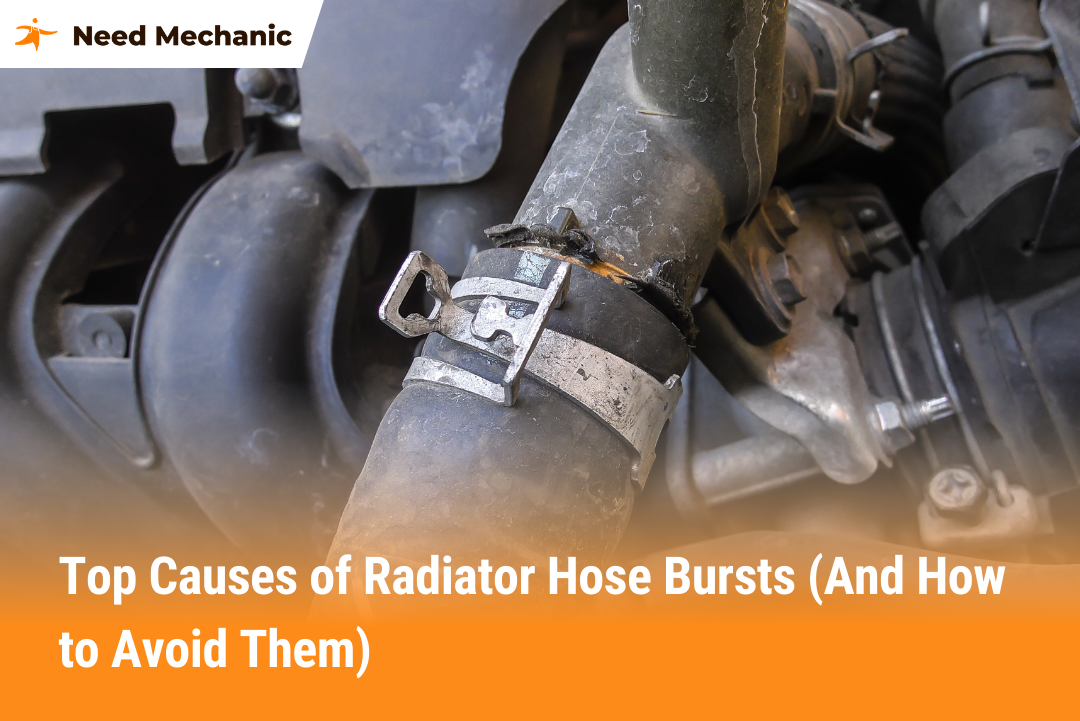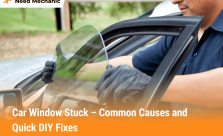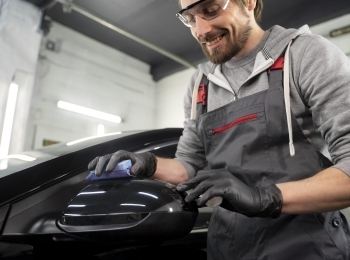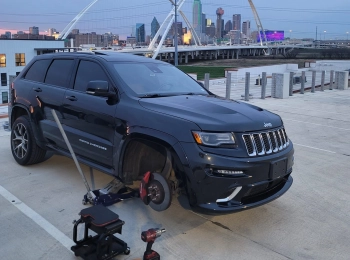A radiator hose burst while driving happens when the rubber hose that carries coolant between your engine and radiator suddenly splits open under pressure, causing coolant to leak and the engine to overheat. This problem can leave you stranded, damage your engine, and cost thousands of dollars if not handled quickly. The good news is that most hose bursts are preventable once you know the main causes and the steps to keep your cooling system healthy.
In this guide, we’ll cover the most common reasons radiator hoses fail, the warning signs to watch for, what to do if it happens on the road, and proven ways to prevent it from ever happening to you.
Table of Contents
Why the Radiator Hose Is So Important
Every engine needs a way to stay cool. The radiator hose plays a critical role by carrying coolant between the radiator and the engine. This flow of coolant keeps the engine from overheating.
- The upper radiator hose connects the engine to the radiator and carries hot coolant away.
- The lower radiator hose sends cooled fluid back into the engine.
If either hose fails, the coolant leaks out, and your engine can no longer regulate its temperature. Within minutes, you can have engine overheating, warped cylinder heads, or even a blown head gasket. That’s why a radiator hose burst while driving is more than an inconvenience, it’s a situation that requires immediate attention.
Top Causes of a Radiator Hose Burst While Driving
Understanding the root causes helps you take preventive action. Here are the main culprits:
1. Old or Worn-Out Hoses
Over time, radiator hoses weaken due to heat cycles, pressure, and age. Rubber becomes brittle and loses flexibility. Cracks, bulges, or soft spots eventually give way under pressure. If your hoses are more than 5 years old, they’re at higher risk.
2. Excessive Heat and Pressure
Engines generate intense heat, especially during long drives or in stop-and-go traffic. If the cooling system is under heavy strain, the pressure inside the hose can spike. Weak hoses may expand like a balloon until they suddenly burst.
3. Poor Coolant Quality or Low Coolant Levels
Coolant isn’t just water with color, it contains additives that prevent rust, lubricate seals, and regulate temperature. If the coolant is old, contaminated, or too low, it increases engine heat and damages hoses from the inside.
4. Loose or Damaged Hose Clamps
The clamps that secure hoses to the radiator and engine can loosen over time. A weak seal lets coolant leak, creating hotspots and weakening the hose walls. In some cases, the hose can pop right off the fitting.
5. Blockages in the Cooling System
A clogged radiator, heater core, or thermostat can cause pressure buildup inside the system. That pressure has to go somewhere, and often it bursts the weakest point: the radiator hose.
6. Oil or Chemical Contamination
Oil leaks or exposure to certain chemicals can soften rubber hoses. Once weakened, they can no longer handle the heat and pressure of normal operation, making them prone to sudden failure.
Warning Signs Before a Radiator Hose Burst
A radiator hose rarely fails without giving at least some early clues. Paying attention can save you from a roadside emergency. Look for:
- Bulging or swelling spots along the hose.
- Cracks, splits, or small leaks at the ends or middle.
- Soft or spongy texture when you squeeze the hose (a healthy hose feels firm).
- Low coolant levels that require frequent topping off.
- Puddles of coolant under your car after parking.
- Steam or sweet smell (coolant has a sugary odor) near the engine.
If you notice any of these signs, don’t ignore them. Replacing a hose at home or in a shop costs far less than repairing an overheated engine.
What to Do If Your Radiator Hose Bursts While Driving
Even with the best care, emergencies can still happen. Here’s what to do if you face this situation:
- Pull Over Safely – As soon as you notice steam, warning lights, or loss of power, turn on your hazard lights and find a safe place to stop.
- Turn Off the Engine – Driving even a short distance with no coolant can destroy the engine. Shut it down immediately.
- Do Not Open the Radiator Cap – The system is under pressure and scalding hot. Opening it can cause severe burns.
- Wait for the Engine to Cool – Give it at least 30–45 minutes before touching anything under the hood.
- Call for Help – If you have roadside assistance, now is the time to use it. If not, you may need a tow.
- Temporary Fix – If you’re experienced and have supplies like duct tape or a hose repair kit, you may be able to patch it long enough to reach a repair shop. But this should never be considered a long-term solution.
How to Prevent a Radiator Hose Burst
Prevention is always cheaper and easier than dealing with a breakdown. Here are practical steps every driver can take:
Regular Inspections
Check your radiator hoses every oil change. Look for cracks, swelling, or leaks. Squeeze them to ensure they still feel firm, not mushy.
Replace Hoses Proactively
Don’t wait until they fail. Most experts recommend replacing hoses every 4–5 years or 60,000 miles, whichever comes first.
Maintain Coolant Levels and Quality
Flush your coolant system as recommended by your vehicle manufacturer, usually every 2-5 years. Always top off with the correct coolant type for your vehicle.
Watch Your Temperature Gauge
If the gauge climbs higher than normal, pull over and check your cooling system. Overheating puts your hoses at immediate risk.
Keep Clamps Tight
Inspect clamps regularly to make sure they’re not loose or corroded. A cheap clamp can prevent an expensive failure.
Fix Oil Leaks Promptly
If oil drips onto your hoses, clean it off right away and address the leak. Oil can weaken rubber quickly.
The Cost of Ignoring a Radiator Hose Burst
Many drivers think, “It’s just a hose.” But the truth is, ignoring this problem can lead to thousands of dollars in repairs:
- Blown head gasket: $1,000–$2,500
- Warped cylinder head: $1,500–$3,000
- Complete engine replacement: $4,000–$7,000 or more
All of these can be triggered by driving just a few miles with no coolant. Compared to that, replacing a hose for $50–$150 is a small investment in peace of mind.
Final Thoughts
A radiator hose burst while driving is one of those problems that feels sudden, but in most cases, it could have been prevented with regular maintenance and inspections. By understanding the common causes, like old hoses, poor coolant, or loose clamps, you can take proactive steps to keep your cooling system in top shape. The key takeaway is this: never ignore the small signs. NeedMechanic notes that a few minutes spent checking your hoses or topping off coolant can save you from an overheated engine, a ruined trip, or thousands of dollars in repairs. Stay alert, stay prepared, and your vehicle will reward you with reliable performance for years to come.
FAQs
What happens if a radiator hose bursts while driving?
When a radiator hose splits under pressure, coolant sprays out immediately, destroying the closed loop required to cool your engine. This causes the engine temperature to spike rapidly. Within minutes, the extreme heat can warp cylinder heads or blow a head gasket, turning a minor maintenance issue into catastrophic engine failure.
How long can I drive with a radiator hose leak?
You should not drive any distance with a bursting or actively leaking radiator hose. The cooling system relies on pressure and fluid volume to function; without them, the engine will overheat almost instantly. Shut the car off immediately and call a tow truck to avoid causing thousands of dollars in permanent engine damage.
Can I use tape to fix a radiator hose?
Duct tape or emergency hose repair kits can serve as a temporary “limp-home” patch if you are stranded, but they cannot withstand the heat and pressure of the cooling system for long. NeedMechanic.com experts emphasize that this is strictly a roadside emergency measure and the hose must be fully replaced by a professional as soon as you reach a shop.
Why do radiator hoses burst more in summer?
High ambient temperatures combined with long drives or stop-and-go traffic put the cooling system under maximum stress. This intense heat increases internal pressure, causing hoses that are already weak, old, or brittle to expand like balloons and eventually rupture at their weakest point.
How often should radiator hoses be replaced?
Radiator hoses should generally be replaced every 4 to 5 years or every 60,000 miles, whichever comes first. Rubber degrades internally over time due to electrochemical degradation (ECD). NeedMechanic recommends squeezing the hoses during every oil change; if they feel soft, spongy, or crunchy, they need immediate replacement regardless of mileage.
Is a radiator hose burst dangerous?
Yes, it presents both mechanical and personal safety risks. Physically, the pressurized steam and 200°F+ coolant can cause severe scalding burns if you open the hood or radiator cap too quickly. NeedMechanic.com advises waiting at least 30 to 45 minutes for the engine to cool completely before attempting any inspection to ensure driver safety.
What should I do immediately if my radiator hose bursts?
Your priority is to pull over safely and turn off the engine immediately to stop the generation of heat. Turn on your hazard lights and do not attempt to open the radiator cap, as the system is under dangerous pressure. Wait for the vehicle to cool down before checking the damage or calling roadside assistance.
What are the signs of a bad radiator hose?
Before a total failure, hoses often exhibit physical warning signs like bulging, swelling, or visible cracks in the rubber. A healthy hose should feel firm; if it feels mushy or soft when squeezed, the internal structure is failing. Additionally, finding puddles of coolant under the car is a clear indicator of a developing leak.
Why does my car smell sweet outside?
A sweet, syrup-like odor coming from the front of your vehicle is a definitive sign of leaking coolant (antifreeze). This often occurs when a hose clamp has loosened or the rubber has developed a pinhole leak. NeedMechanic.com suggests that if you catch this scent early, you can often replace the hose before it bursts and strands you on the road.
Cost to replace radiator hose vs engine repair?
Replacing a radiator hose is a low-cost maintenance item, typically ranging from $50 to $150. In contrast, ignoring the hose until it bursts can lead to engine overheating that warps cylinder heads or cracks the engine block, resulting in repair bills between $1,500 and $7,000.












Leave a Reply